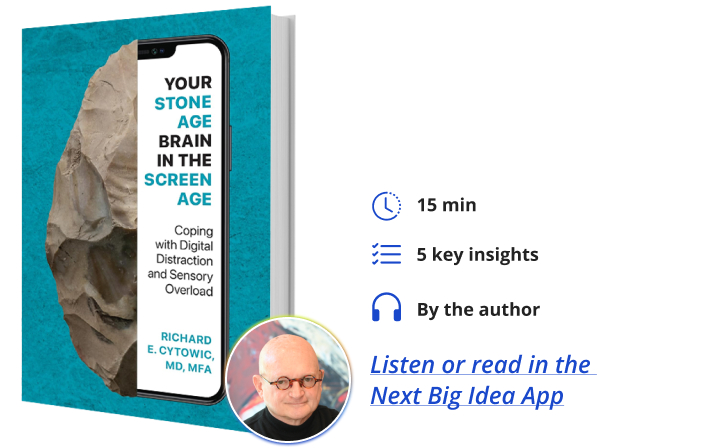Richard Cytowic is a neurologist, neuropsychologist, and textbook writer. He specializes in metacognition. He is a Professor of Neurology at George Washington University. His New York Times Magazine cover story about the Presidential Press Secretary James Brady received a 1982 Pulitzer Prize nomination.
What’s the big idea?
Human brains are products of the Stone Age, and the sensory overload of Digital Age life threatens the natural, optimal functioning of that fundamental biology. Richard Cytowic, an award-winning neurologist, explains why our minds struggle to thrive amid the mass of new addictive technologies and how our modern screen habits are of incredible detriment to happiness and performance. Fortunately, science holds the possibility of how to break the curse digital devices have cast over our lives.
Below, Richard shares five key insights from his new book, Your Stone Age Brain in the Screen Age. Listen to the audio version—read by Richard himself—in the Next Big Idea App.

1. The brain operates within fixed energy limits.
I use the term “Stone–Age” because modern brains are no different from those of our distant ancestors. They have not evolved, whereas technology has grown exponentially. I focus on digital distractions and the detrimental effects of phones and screens on our minds. Attention spans have gone to hell. People say, “I’m addicted to my phone,” then spend hours scrolling through TikTok or Instagram, unable to cut back no matter how much they say they want to. People wrongly look at the issue as a matter of external forces rather than from the brain’s perspective.
I also think in engineering terms: what does it cost in energy to perform a certain action or think a certain thing? No amount of diet, exercise, or Sudoku puzzles can increase available energy. Willpower and a pot of coffee are, likewise, useless. If we can’t overcome the brain’s inherent energy limits, then we need to work with what we have. The idea that planks and Pilates can boost brain power is a fantasy.
The biological brain is an energy hog. It accounts for only 2 percent of body weight yet consumes 20 percent of the daily calories we burn. Most go towards maintaining physical structures by pumping sodium and potassium ions across membranes. There is precious little left over for mental work.
That’s why we’re so awful at multitasking and coping with sensory overload. An overload of working memory is the reason behind the Oscar fiasco in which presenters were handed the wrong envelope for Best Picture. The culprit was Tweeting about Emma Stone the very moment he should have been cueing up the next envelope. Your attention cannot hold two things at once.
2. People’s appetite for mental garbage.
People obsess over what they put in their bodies: organic, vegan, gluten-free, no artificial colorings. Why aren’t they as picky about what they take in through the senses? The mental garbage we ingest is arguably more harmful than an occasional cheeseburger and fries. Some individuals fast for health or religious reasons. What if it were possible to indulge in a sensory fast for a day—or even an hour—free from texts, tweets, videos, emails, and other digital junk food?
“The mental garbage we ingest is arguably more harmful than an occasional cheeseburger and fries.”
Our brains did not evolve to crave constant stimulation; they crave face–to–face social engagement. To a baby, nothing is more fascinating than a human face. They lock onto it, follow it, and smile as their pupils dilate. Every parent and grandparent knows this. So why do we block our real faces from one another with mediated images on phones and tablets?
Thousands of likes, follows, and online acquaintances are nothing compared to an intimate connection with the person sitting next to us. We’ve all seen people gathered around, each staring alone into their cellphone, failing to engage with the person a foot away. Is it any wonder why there is an epidemic of loneliness?
3. Screens induce virtual autism.
Virtual autism is the development of autistic-like behaviors in otherwise normal youngsters who are exposed to heavy amounts of screen media, especially gaming. The term “virtual autism” was introduced in 2018 by psychiatrist Marius Teodor Zamfir, who studied children exposed to prolonged screen time. Though behaviors mimic those of autism spectrum disorder (ASD)—avoiding eye contact, social withdrawal, delayed language, and reduced imaginative play—these children typically recover once screen time is drastically reduced or eliminated.
Young brains are malleable and molded by whatever environment they are exposed to. Critical windows, particularly during the first two years of life, are essential for growing connections in brain areas responsible for vision, language, and social cognition. Screens interfere with this natural development by reinforcing pathways that prioritize sensory gratification—such as rapid sequences of sights and sounds—at the expense of those for social and emotional intelligence, empathy, and imagination.
4. Screens act like secondhand smoke.
Just as we learned to shield ourselves from cigarette fumes, we can guard against unwanted screen exposure. Monitors play cooking shows while you’re on the treadmill. Advertisements beckon in subway stations and bus shelters. Can you remember when those used to be quiet spaces where you could be alone with your thoughts? You probably can’t. Trying not to look is hard if not impossible. You may have an hour to kill at the airport, but a monitor in the lounge blasts out the latest news as if the updates on the bottom crawl were something you couldn’t live without knowing right now. It seizes your attention like a moth to a flame and holds it. Screens demand to be looked at.
“We can set boundaries for when and where we use our devices, who we let text us, and what companies we allow to send us push notifications.”
We can reclaim our attention, but it takes effort. Screens will always be proliferating. We can learn, however, to coexist with them by establishing screen-free zones and socializing face–to–face more often with others. We can set boundaries for when and where we use our devices, who we let text us, and what companies we allow to send us push notifications. It is easier said than done, but you must begin somewhere. The strongest thing you can do is begin and keep at it.
5. iPads are the worst babysitter and a form of child abuse.
We once lived in a slow-paced, natural world of green environments. Resources our ancestors once fought for now overwhelm us. Today’s technology, promised to enrich our lives, has been crafted to hold users’ attention as long as possible. There are only 1,440 minutes in a day, and tech companies fight ruthlessly for our eyeballs, making it hard to disengage.
Hook an infant on an iPad, and you have a customer for life. Exasperated parents may say they’re the only thing that keeps kids quiet, but the iPad is the worst babysitter ever. Shoving one in front of a youngster or dangling it over a bassinet is a form of child abuse, in my opinion, because doing so blocks the development of their central vision. Normal vision is 20/20; a newborn’s acuity is 20/400. Color vision becomes functional around four to six months, as do other networks for decoding the perceptual complexity of movement.
Despite their underdeveloped vision, newborns are astute social creatures: locking onto an adult’s dilated pupils is a common sign of interest and pleasure that makes them smile. iPads interfere with this natural development. Screen characters don’t talk with a child but rather at them. They provide none of the emotional, social, and linguistic cues that pour forth when a child interacts with a real parent or grandparent.
Critical windows within the first two years exist for the growth of brain areas responsible for vision, language, and emotional intelligence, including Theory of Mind, which entails learning how to read others—a skill that develops long before we learn to speak. Screens interfere with the natural maturation sequence by reenforcing pathways that prioritize immediate sensory gratification over pathways destined for this kind of emotional intelligence.
To listen to the audio version read by author Richard Cytowic, download the Next Big Idea App today:































